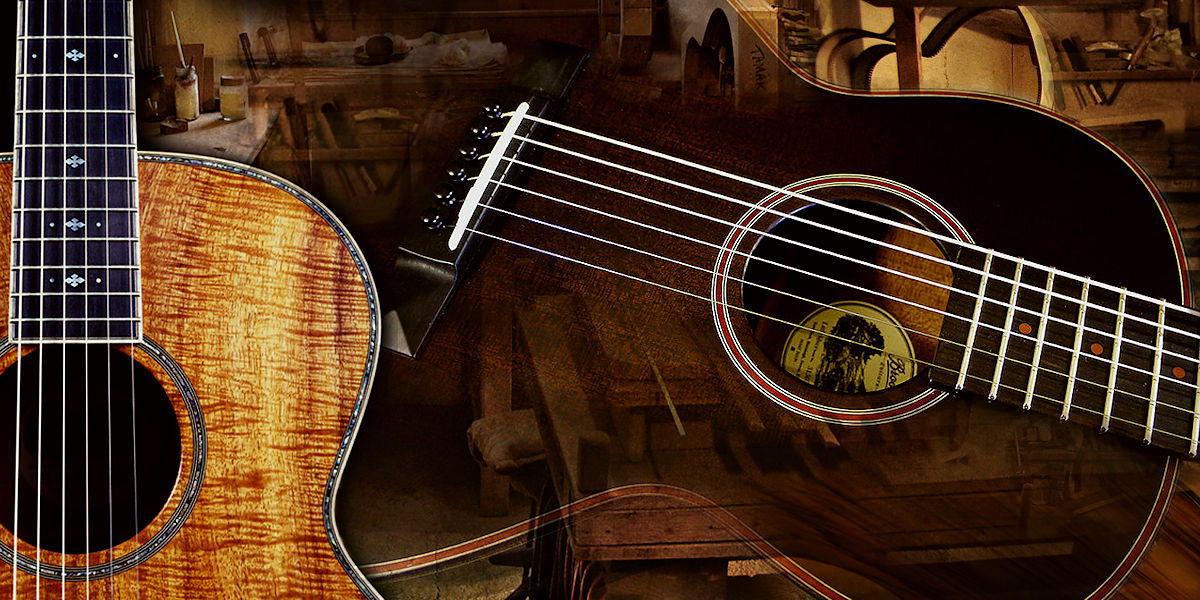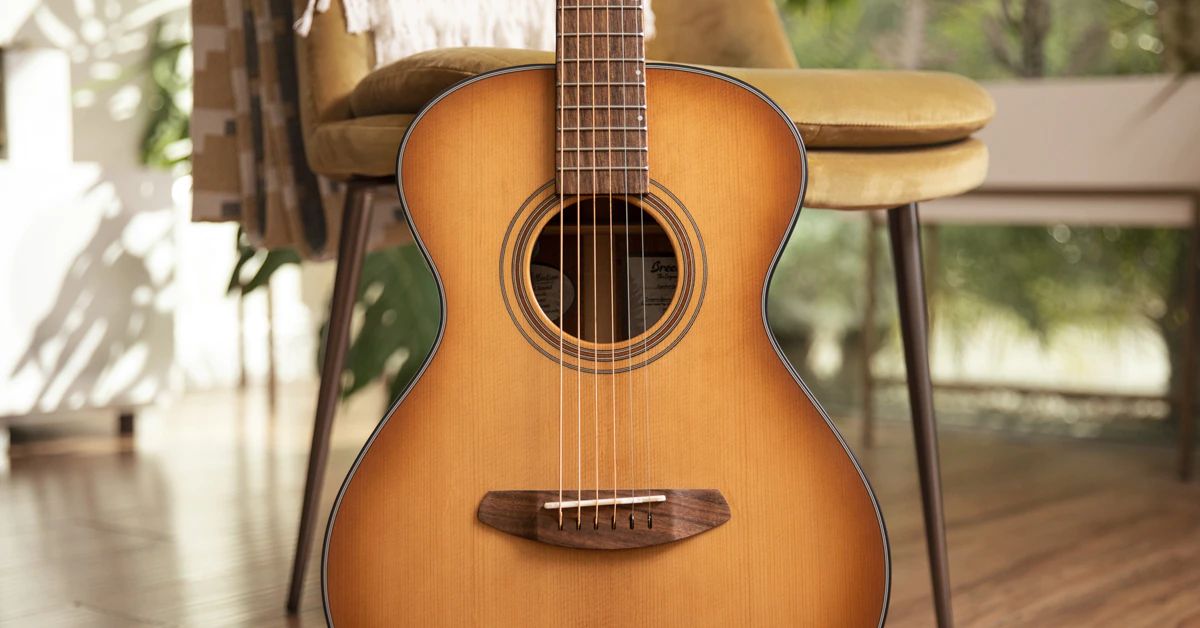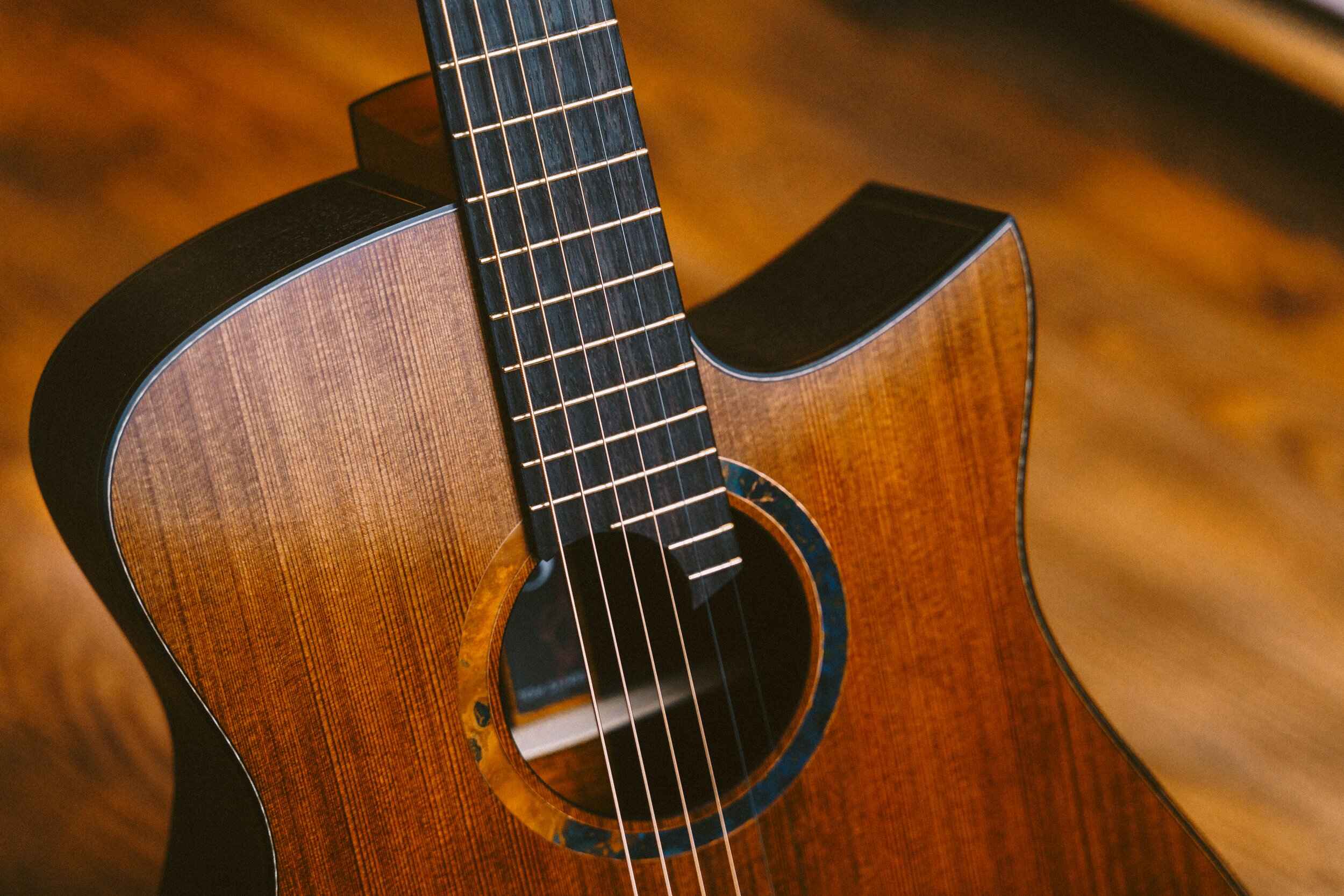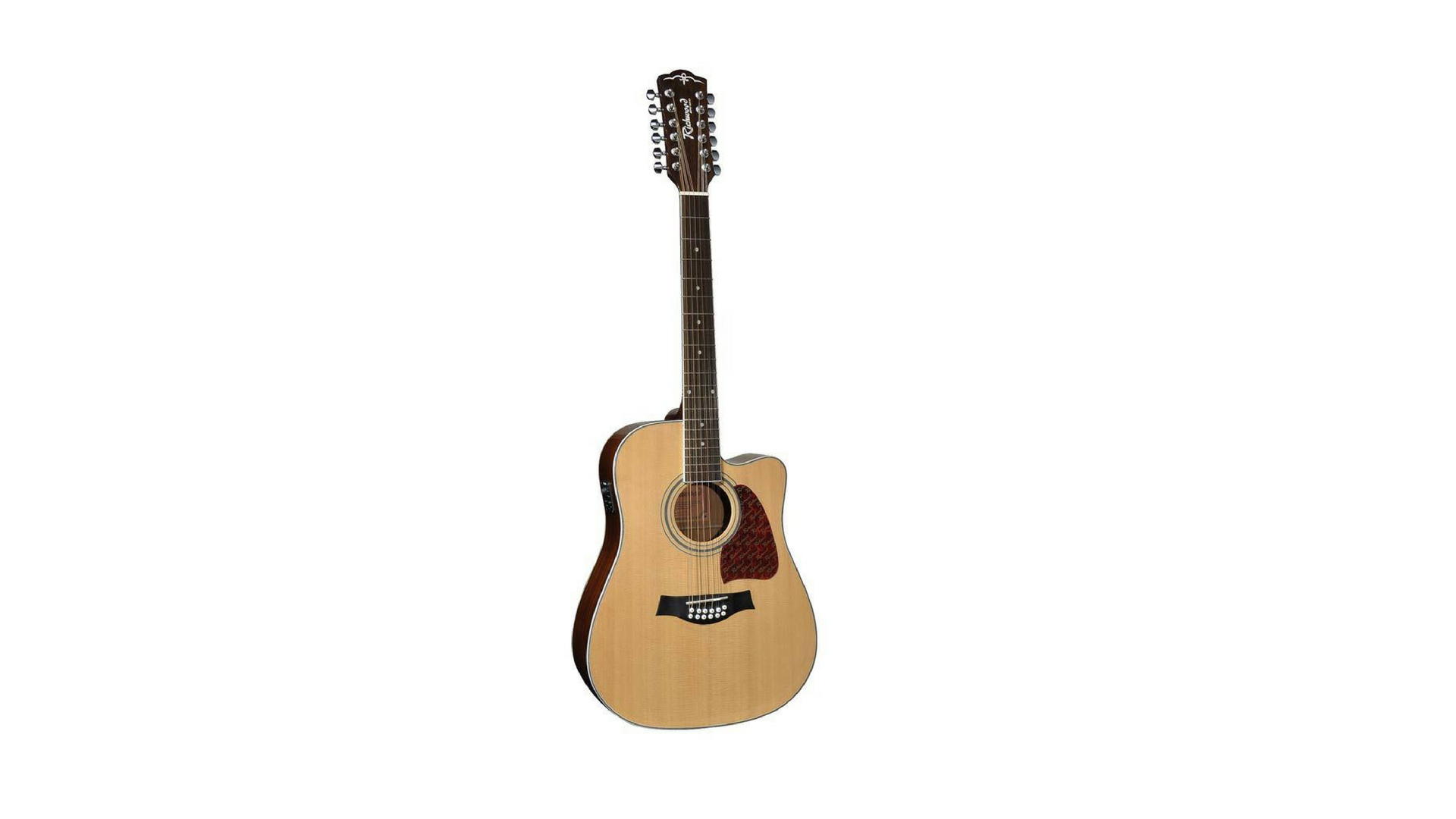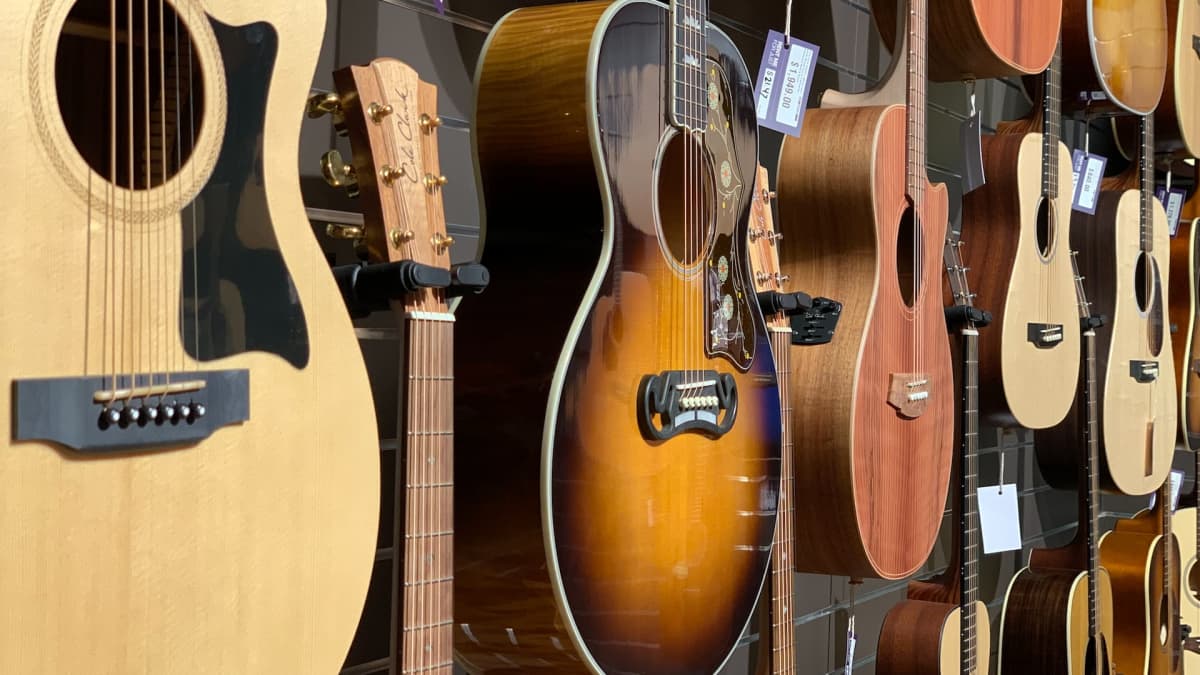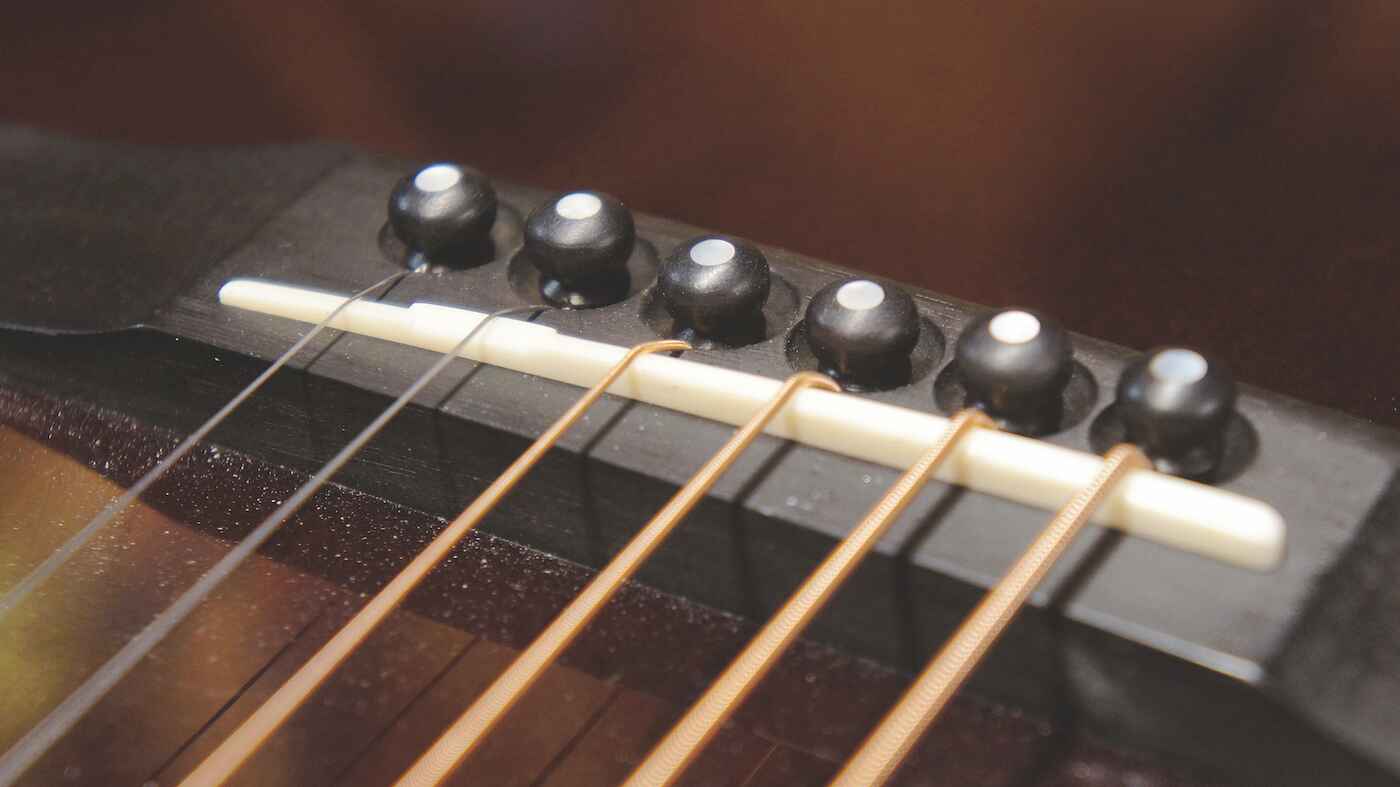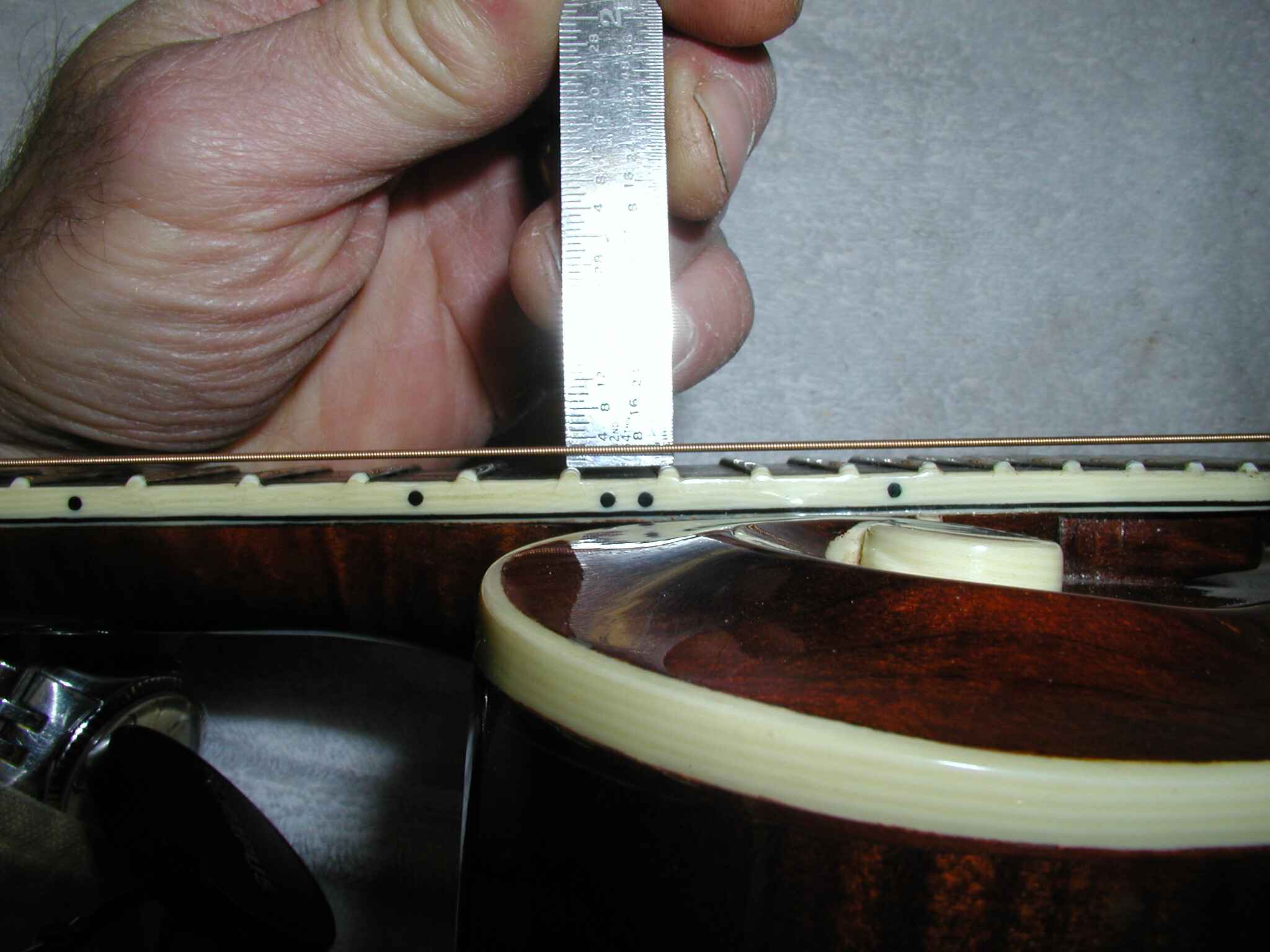Introduction
An acoustic guitar is a beloved and widely recognized musical instrument that has been used for centuries across different genres and cultures. Its unique and rich sound has made it a staple in various music styles, from folk and country to rock and pop. But have you ever wondered what an acoustic guitar is made of? In this article, we will explore the different components of an acoustic guitar and shed light on the materials that make this instrument so special.
The construction of an acoustic guitar involves several key components that work together to produce its distinctive tone. Each part plays a vital role in shaping the sound and enhancing the playability of the instrument. From the top to the bottom, every element contributes to creating a balanced and resonant sound that guitarists and listeners alike adore.
In the following sections, we will delve into the specifics of each component, including the top, back, and sides, as well as the soundhole, neck, fretboard, frets, headstock, nut and saddle, and bridge. By understanding the materials and construction of an acoustic guitar, you will gain a deeper appreciation for this instrument and its timeless craftsmanship.
The Body
The body of an acoustic guitar is the main structure that houses the instrument’s sound-producing components. It is typically made up of three key parts: the top, the back and sides, and the soundhole.
The top, also known as the soundboard, is the face of the guitar. It is usually made of a solid piece of wood, such as spruce or cedar. The top is responsible for transmitting the vibrations produced by the strings and amplifying the sound. Different types of wood can produce different tonal qualities, with spruce offering a bright and articulate sound, while cedar provides a warmer and more mellow tone.
The back and sides of the guitar are responsible for reflecting and amplifying the sound produced by the top. They are typically made of hardwoods like mahogany, rosewood, or maple. These woods not only contribute to the overall tone of the guitar but also add to its aesthetic appeal. The back and sides are carefully shaped and joined to create a sturdy and resonant body.
The soundhole, often located in the center of the guitar’s top, allows the sound to escape from the body. Its size and shape can greatly impact the guitar’s sound projection and tone. The soundhole is usually adorned with a decorative rosette, which adds an artistic element to the guitar’s design.
The body of an acoustic guitar is meticulously crafted to ensure optimal resonance and projection. The choice of woods, the thickness and bracing of the top, as well as the overall design, all play a role in shaping the instrument’s sound. A well-made body can produce a balanced and vibrant tone, making the guitar a joy to play and listen to.
The Top
The top of an acoustic guitar, also known as the soundboard, is a vital component that significantly influences the instrument’s tone and projection. It is typically made of a solid piece of wood, carefully selected for its acoustic properties and visual appeal.
The most commonly used wood for the top of an acoustic guitar is spruce. Spruce is highly valued for its excellent strength-to-weight ratio, which allows it to vibrate freely and produce a bright and resonant tone. Sitka spruce is a popular choice for its balanced tone, while Engelmann spruce offers a more mellow and nuanced sound. Cedar is another popular option, known for its warmth and responsiveness, producing a mellower and darker tone compared to spruce.
The top is carefully carved to a specific thickness, which contributes to the guitar’s overall tonal characteristics. Thicker tops generally produce a more pronounced bass response, while thinner tops offer enhanced treble and clarity. The thickness is also crucial in preventing the top from collapsing under the pressure of the strings and ensuring proper resonance.
To further enhance the top’s structural integrity and tonal qualities, it is reinforced with bracing. The bracing pattern, typically made of wood strips, is carefully positioned on the inside of the top. It provides support to prevent excessive vibrations and helps distribute the sound evenly across the surface. Common bracing patterns include X-brace, scalloped, and ladder bracing, each offering different tonal nuances.
In terms of aesthetics, the top is often adorned with bindings and purflings. Bindings are strips of decorative wood or plastic that frame the edges of the top, adding a touch of elegance and protecting it from accidental bumps or dings. Purflings are usually thin strips of contrasting wood or decorative inlays, adding visual interest and enhancing the guitar’s overall appearance.
The top of an acoustic guitar is a crucial element responsible for the instrument’s tone, projection, and responsiveness. Its carefully selected wood, precise carving, and reinforcing bracing all contribute to creating a rich and vibrant sound. Whether you prefer the bright and articulate tone of spruce or the warm and mellow sound of cedar, the top plays a crucial role in shaping the character of your acoustic guitar.
The Back and Sides
The back and sides of an acoustic guitar are integral components that work together with the top to create a balanced and resonant sound. While the top is responsible for transmitting the vibrations and projecting the sound, the back and sides play a vital role in reflecting and amplifying that sound.
The back and sides of acoustic guitars are typically made of hardwoods such as mahogany, rosewood, or maple. These woods are chosen for their tonal characteristics and durability. Mahogany is known for its warm and focused sound, while rosewood offers a rich and complex tone. Maple, on the other hand, provides a bright and clear sound with excellent note definition.
The back and sides of the guitar are carefully shaped and joined together to form a solid and sturdy body. The wood is carefully selected for its visual appeal, grain pattern, and resonance. The skilled craftsmanship involved in constructing the back and sides is crucial in ensuring a seamless and tight fit, as any gaps or inconsistencies can affect the guitar’s sound quality.
In addition to their acoustic properties, the back and sides also contribute to the overall aesthetic of the guitar. The natural beauty of the wood grain is often showcased through a glossy finish, enhancing the instrument’s visual appeal. Some guitars may also feature decorative inlays or bindings along the edges, adding a touch of elegance and craftsmanship.
The thickness of the back and sides can influence the guitar’s sound. Thicker backs and sides can produce a deep and rich tone, while thinner ones offer a more focused and bright sound. The choice between thicker or thinner materials depends on the desired tonal qualities and the guitar maker’s preferences.
When strummed or plucked, the vibrations of the strings transfer to the top, which in turn vibrates the back and sides, resulting in a resonant and well-rounded sound. The back and sides act as a sounding board, reflecting and projecting the vibrations back into the air, creating volume and depth.
Overall, the back and sides of an acoustic guitar are essential components that contribute to the instrument’s tonal qualities, resonance, and aesthetics. The choice of wood, craftsmanship, and design all play a significant role in creating a guitar that not only sounds great but also looks visually stunning.
The Soundhole
The soundhole is a small opening located on the top of an acoustic guitar, directly below the strings. Despite its small size, the soundhole plays a crucial role in the instrument’s sound production.
The primary purpose of the soundhole is to allow the sound vibrations generated by the strings to escape from the guitar’s body. As the strings are plucked or strummed, they create vibrations that resonate through the body of the guitar. Without a soundhole, these vibrations would be trapped inside the instrument, resulting in a muffled and low-volume sound.
The size and shape of the soundhole significantly impact the guitar’s tone and projection. Larger soundholes tend to produce bigger and more resonant sound, with enhanced volume and bass response. Smaller soundholes, on the other hand, can offer a more precise and focused sound, with improved clarity and treble response.
The soundhole is typically round or oval-shaped, although some guitars may feature unique designs or decorative rosettes surrounding the opening. These rosettes not only add a touch of visual appeal to the guitar but can also affect the sound by influencing the way air moves into and out of the soundhole.
In addition to its sonic role, the soundhole also serves as a structural component of the guitar. It helps relieve the stress on the top, preventing it from warping or collapsing under the tension of the strings. The bracing beneath the soundhole provides additional support, ensuring the longevity and stability of the instrument.
While the soundhole’s primary function is acoustic, it also adds to the aesthetics and overall beauty of the guitar. Many soundholes are decorated with intricate designs, inlays, or bindings, complementing the instrument’s visual appeal. These decorative elements can range from simple patterns to elaborate motifs, adding a touch of artistry to the guitar’s appearance.
Overall, the soundhole is a crucial component of an acoustic guitar. It allows for the release of sound vibrations, shapes the instrument’s tone, and contributes to its structural stability. From its size and shape to the decorative details surrounding it, the soundhole is an essential element that enhances both the sound and aesthetics of the guitar.
The Neck
The neck of an acoustic guitar is a vital component that connects the body of the instrument to the headstock. It serves as the main support for the fretboard, frets, and strings, allowing the player to manipulate the pitch and create different musical notes.
The neck is typically made from a single piece of wood, often mahogany or maple, chosen for its stability, strength, and resistance to warping. Mahogany necks are known for their warmth and balanced tone, while maple necks offer brightness and clarity. The wood is carefully selected and shaped to provide a comfortable grip and facilitate smooth movement along the fretboard.
The neck is attached to the body using a joint known as the neck joint or heel. This joint is essential for maintaining structural integrity and transferring vibrations from the body to the neck. The type of neck joint can vary between guitars, with common options including bolt-on, set neck, and neck-through constructions.
One of the key features of the neck is its curvature, known as the neck relief or bow. The neck relief is carefully set to ensure proper string clearance and playability. The truss rod, a metal rod embedded in the neck, allows for adjustments to the neck relief, ensuring optimal playability and preventing issues such as buzzing or high action.
The neck also features markers or inlays along the fretboard. These markers help guitarists navigate the fretboard and locate specific positions or chords. Common markers include dots, blocks, or even elaborate inlay designs, adding both functionality and visual appeal.
To enhance playability, the neck is usually finished with a smooth and comfortable surface. It may be coated with a thin layer of lacquer or oil, providing a sleek feel and protecting the wood from wear and moisture damage.
The neck of an acoustic guitar is a crucial element that directly influences playability and comfort. A well-crafted neck allows for easy fretting, smooth transitions, and accurate intonation. Its design, wood choice, and construction are all carefully considered to ensure an enjoyable playing experience for guitarists of all skill levels.
The Fretboard
The fretboard, also known as the fingerboard, is the flat, usually wooden, surface that spans the length of the neck on an acoustic guitar. It is a crucial component where the strings are pressed against to produce different notes and chords.
The most common wood used for the fretboard is rosewood. Rosewood is prized for its smooth texture, durability, and warm tonal qualities. Other woods, such as ebony or maple, are also used for their unique tonal characteristics and visual appeal.
The fretboard is marked with frets, which are thin metal strips embedded perpendicular to the strings. These frets serve as guides for the player, indicating where to press the strings to create specific pitches. The spacing between the frets determines the guitar’s scale length, affecting both the playability and tonal characteristics.
The width and radius of the fretboard also contribute to the overall feel and playability of the guitar. The width affects the spacing between the strings, allowing for comfortable finger placement and chord formations. The radius refers to the curvature of the fretboard, with a flatter radius providing a more even surface for fingerings and bends, while a rounder radius offers a more comfortable grip for playing chords.
To aid in navigation along the fretboard, markers or inlays are often present. These markers can be in the form of dots, blocks, or even intricate designs, typically placed at specific fret positions. These markers not only enhance the guitar’s visual appeal but also provide a visual reference for players to locate specific positions, especially when playing without looking at the fretboard.
The fretboard is subjected to wear and tear from the constant pressure and friction of the strings and the player’s fingers. To protect and maintain the fretboard, it is often treated with oils or finishes to keep it moisturized and resistant to moisture damage.
In summary, the fretboard of an acoustic guitar is a vital component that facilitates the production of various notes and chords. Its choice of wood, fret spacing, width, radius, and markers all contribute to the playability, comfort, and aesthetics of the instrument. Whether you’re a beginner or an experienced player, the fretboard is where the magic happens, allowing you to explore the full potential of the guitar’s sound.
The Frets
The frets on an acoustic guitar are thin metal strips embedded into the fretboard, running perpendicular to the strings. These frets play a crucial role in determining the pitch and intonation of the notes produced when the strings are pressed against them.
The number of frets can vary between different guitar models, but the most common number is 20 or 21 frets. Some guitars, particularly those designed for advanced players, may have more frets, extending the playable range of the instrument.
The spacing between each fret is determined by the scale length of the guitar, which is the distance between the nut and the bridge. This spacing ensures that each fret represents a semitone or half-step, allowing for precise and accurate note intervals.
As a player presses a string down behind a fret, it shortens the vibrating length of the string, resulting in a higher pitch. The placement of the fingers on the fretboard changes the effective length of the vibrating string, enabling the guitarist to create different notes and chords.
The frets serve as visual and tactile guides for players, helping them locate specific notes and positions on the fretboard. Inlaid markers, usually dots or blocks, are often placed on certain frets, usually the third, fifth, seventh, ninth, twelfth, fifteenth, seventeenth, nineteenth, and sometimes the twenty-first fret. These markers assist in orientation while playing, especially when transitioning between different positions.
Over time, the frets can experience wear, especially in areas where the strings make contact. This wear can cause unevenness or grooves on the frets, affecting playability and intonation. To address this, guitarists may seek professional maintenance to level or replace worn frets, ensuring optimal performance.
Frets play a crucial role in the playability and intonation of an acoustic guitar. Their placement, spacing, and condition directly impact the accuracy and quality of the notes produced. Whether you’re strumming chords or playing intricate melodies, the frets play an essential part in unlocking the full potential of the instrument.
The Headstock
The headstock of an acoustic guitar is the portion located at the end of the neck, opposite the body. It serves several important functions, including housing the tuning pegs, providing support for the strings, and contributing to the instrument’s overall aesthetics.
The headstock is typically made from the same piece of wood as the neck, creating a seamless transition between the two. It is designed to provide stability and strength, ensuring that the strings remain properly tensioned and in tune.
One of the key features of the headstock is the tuning pegs, also known as machine heads or tuners. These pegs allow the player to make precise adjustments to the tension of each string, enabling them to tune the guitar to the desired pitch. Tuning pegs can be either open-gear or enclosed, and they play a significant role in maintaining accurate intonation.
Another crucial aspect of the headstock is the nut, a small piece of bone, plastic, or synthetic material located at the end of the fretboard. The nut acts as a guide, providing proper spacing and height for the strings as they cross from the fretboard to the headstock. It aids in maintaining consistent string action and preventing buzzing or string slippage.
The headstock is also an opportunity for guitar manufacturers to showcase branding, logos, or decorative elements. Many guitar companies have distinctive headstock shapes or designs that are instantly recognizable. These visual elements not only add to the instrument’s aesthetic appeal but also give the guitar its unique identity.
In addition to its practical and aesthetic functions, the headstock can also impact the guitar’s resonance and tone. The shape and weight distribution of the headstock can affect the overall balance and vibrations of the instrument. Different headstock designs may have subtle influences on sustain, harmonics, or even the characteristics of a guitar’s sound.
The headstock, while often overshadowed by other components, plays an essential role in the functionality and visual appeal of an acoustic guitar. From housing the tuning pegs and nut to contributing to the guitar’s overall tone, the headstock is a critical feature that should not be overlooked. It serves as the gateway to perfectly tuned strings and completes the instrument’s distinctive look and personality.
The Nut and Saddle
The nut and saddle are two small yet crucial components of an acoustic guitar that directly influence the instrument’s playability, intonation, and tone. Located at either end of the fretboard and the bridge, respectively, the nut and saddle play an integral role in transmitting and maintaining the vibrations of the strings.
The nut is a small piece, typically made of bone, plastic, or synthetic materials, that is situated at the end of the fretboard. Its main function is to support and elevate the strings above the fretboard, providing proper spacing and clearance. The slots in the nut hold the strings securely in place, allowing them to vibrate freely and produce clear and distinct notes.
The nut spacing and height are essential for maintaining accurate string action and preventing buzzing or string slippage. The strings need to be adequately spaced to avoid unintentional contact with adjacent frets, as this can result in muffled or buzzy sound. Proper height ensures that the strings are neither too high nor too low, making it easier for players to fret the strings without straining their fingers.
As for the saddle, it is a small piece positioned on the bridge, serving as a connection point for the strings and the guitar’s body. Like the nut, the saddle is typically made of bone, plastic, or synthetic materials. Its primary function is to transmit the vibrations from the strings to the soundboard, amplifying the sound produced by the guitar.
The positioning and height of the saddle are crucial for ensuring proper intonation and tone. The saddle needs to be precisely placed to maintain accurate string length and pitch. Adjustments to the saddle placement can be made to address intonation issues, ensuring that the guitar plays in tune across all frets.
The materials used for the nut and saddle can also impact the guitar’s overall tone and sustain. Bone is a common choice due to its ability to transfer vibrations efficiently and its durability. Plastic and synthetic materials are also utilized, often providing a similar tonal response while offering increased consistency and affordability. The choice of material for the nut and saddle ultimately depends on personal preference and desired tonal characteristics.
Overall, the nut and saddle may seem like small components, but they play a significant role in the overall playability, intonation, and tone of an acoustic guitar. Their proper placement, materials, and adjustments are essential for ensuring that the guitar performs optimally, allowing players to produce clear, in-tune, and resonant notes.
The Bridge
The bridge is a critical component of an acoustic guitar, serving as an anchor point for the strings and enabling their vibration to resonate through the body. It is located on the body of the guitar, opposite the soundhole, and works in conjunction with the saddle to transmit the vibrations and produce sound.
The bridge is typically made of wood, such as rosewood or ebony, known for its strength, stability, and tonal properties. It is meticulously crafted to provide a stable platform for the strings and to transfer their vibrations effectively to the soundboard.
The main function of the bridge is to maintain proper string alignment and tension. The strings are securely anchored on the bridge, often through bridge pins or knots, ensuring that they remain in place during play. The spacing between the strings is carefully set to provide adequate room for picking, strumming, or fingerstyle techniques.
One crucial component of the bridge is the saddle, which is placed in a slot on the bridge. The saddle, usually made of materials like bone or synthetic materials, contributes to the transmission of vibrations from the strings to the soundboard. It plays a crucial role in determining the guitar’s intonation by adjusting the string length and positioning.
The bridge also impacts the guitar’s tone and sustain. The shape, size, and material of the bridge can affect the balance of frequencies, sustain, and overall projection of the instrument. Different bridge designs, such as the classic belly bridge or the more modern pinless bridge, can have subtle differences in tonal characteristics.
Another essential aspect of the bridge is its ability to support and enhance the guitar’s resonance. Its connection to the soundboard allows the vibrations generated by the strings to resonate throughout the body, contributing to its overall volume and tone. The bridge’s construction and placement are crucial for optimizing this resonance and maximizing the guitar’s acoustic properties.
Care and maintenance of the bridge are essential to ensure its longevity and performance. Regular cleaning and inspection of the bridge prevent build-up of dirt or debris that could affect the string height or contact with the saddle. Additionally, proper string changing techniques help prevent damage to the bridge and maintain its structural integrity.
In summary, the bridge of an acoustic guitar is a crucial component that supports the strings, transmits vibrations to the soundboard, and influences the guitar’s tone and resonance. Its design, material, and construction are all carefully considered to ensure optimal performance, playability, and tonal characteristics.
Conclusion
The construction and components of an acoustic guitar work together to create a harmonious blend of tone, resonance, and playability. From the top to the bridge, each element plays a vital role in shaping the instrument’s sound and overall aesthetic appeal.
The top, with its choice of wood and bracing patterns, determines the instrument’s tonal qualities and responsiveness. The back and sides provide reflection and projection of sound, adding warmth and depth to the guitar’s tone. The soundhole allows the vibrations to escape, ensuring clarity and volume.
The neck, fretboard, and frets offer the ability to produce different notes and chords, providing the guitarist with versatility and flexibility. The headstock, nut, and saddle contribute to the stability, tuning, and tonal transmission of the strings. Lastly, the bridge anchors the strings, transfers their vibrations to the soundboard, and enhances the guitar’s resonance.
Understanding the materials and construction of an acoustic guitar provides a deeper appreciation for the instrument’s craftsmanship and helps players make informed choices when selecting their ideal guitar. Whether it’s the bright tones of spruce or the warm richness of rosewood, each choice carries its own sonic characteristics.
Moreover, the time-honored techniques and attention to detail employed in creating these components ensure that each acoustic guitar is a unique masterpiece with its own personality and sound signature.
Ultimately, the combination of these components results in an instrument that is more than just the sum of its parts. An acoustic guitar is a vessel for artistic expression, a gateway to creativity, and a timeless companion for musicians around the world.
So, whether you’re strumming chords or fingerpicking melodies, remember to appreciate the craftsmanship and design that goes into every acoustic guitar. Embrace the rich and resonant sound, explore the full range of tones, and enjoy the boundless musical possibilities that this remarkable instrument has to offer.







